
Seeking a Better Society for Children of Multicultural Backgrounds
The number of residents from overseas in Japan has risen sharply since 1990. The figure doubled in a period of about ten years, and as of the end of 2005 there were over two million persons of non-Japanese citizenship, making up 1.57 percent of the total population, residing in Japan. They represent 186 nationalities, and the top six are, in descending order, South/North Korean, Chinese, Brazilian, Filipino, Peruvian, and American. For most of the twentieth-century, the majority were Korean residents, 1 including those who had been living in Japan since the 1920s, but since the mid-1980s, the numbers of newly arrived Chinese, Filipino, Korean, and ethnic Japanese Brazilians 2 have increased rapidly. Some of the trends that have driven the rise in their numbers are globalization and a shortage of manual laborers resulting from the falling birthrate and the aging of the population in Japan.
Number of Persons Registered as Aliens in Japan
(Based on Annual Report on Statistics on Legal Migrants, Ministry of Justice, 1961-2005)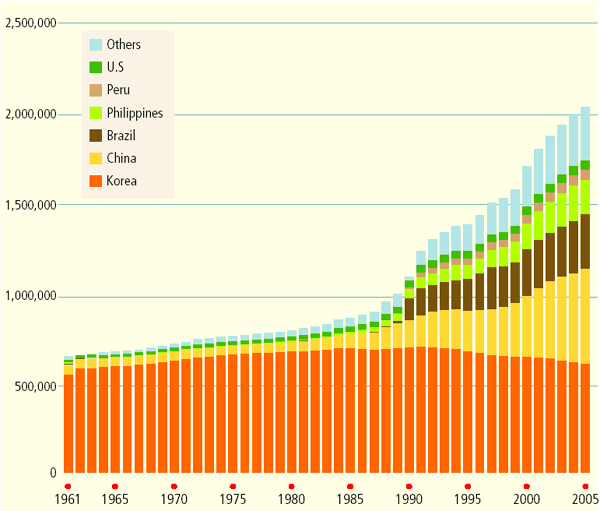
Issues for Children of Multicultural Backgrounds
In recent years, extended stays by persons of non-Japanese citizenship have led to a variety of new issues such as their education in the Japanese language, employment conditions, and human rights. As a result of the growing numbers of non-nationals who have come to Japan with their families as well as the increase in international marriages, there have arisen problems such as securing the right for children of non-Japanese citizenship to attend school, Japanese language education for non-native speakers, education to maintain the children’s first languages, and maintaining children’s identities. Reponses to such issues have not yet been sufficient, but steady efforts are being made to meet the needs that have emerged. In this issue of Takarabako, we take a look at the ways in which efforts are being made by schools, citizens, and government to resolve the problems facing children of multicultural backgrounds. 3
At School: Okubo Elementary School
Changes Came with Accepting Differences.
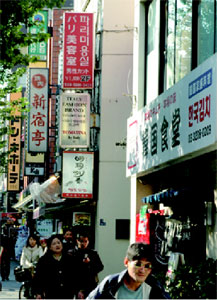 Tokyo has the largest number of residents of overseas citizenship in the country, and within Tokyo, Shinjuku ward has the largest number, with approximately 30,000. This means that one in every ten Shinjuku ward residents holds overseas citizenship, from one of over 30 countries.
Tokyo has the largest number of residents of overseas citizenship in the country, and within Tokyo, Shinjuku ward has the largest number, with approximately 30,000. This means that one in every ten Shinjuku ward residents holds overseas citizenship, from one of over 30 countries.
The Okubo area of Shinjuku ward boasts the largest Koreatown in the Kanto region,
and it is a tourist spot with a variety of Asian restaurants and shops. Of
the 159 students enrolled at Okubo Elementary School, approximately 60 percent
are students who have close connections to other countries. Twelve countries,
including Korea and China, are represented in the student body.
Many of these students struggle with the
language barrier, having difficulty understanding their teachers and friends
or not being able to express themselves adequately, and as a result, have had
trouble with their studies and in other aspects of their school life.
The streets of Okubo are full of signs written in Hangul, Korean script. ->
Creating a Supportive Learning Environment
Okubo Elementary School has undertaken a number of programs to improve these students’ Japanese language abilities.
4
The Shinjuku ward board of education has placed bilingual teachers in the school to teach Japanese. Even after the students’ period of Japanese language instruction is over, for two years, they may spend their Japanese-language (kokugo) class and other class hours in a “Japanese as a second language (JSL)” class.
For these students to improve their Japanese language ability, however, steps also need to be taken in regular classes in addition to the special language teaching program. In schools where all the students are Japanese, teachers do not question the effectiveness of a single method in responding to students’ needs. However, in this school, where students hold a variety of values and worldviews, it was not so simple. Reexamining their teaching methods, the teachers tried to better understand their students’ circumstances and began to study, every day and every period, what they could improve upon.
As a result, the teachers reached the conclusion that for the students to improve their Japanese language ability and solve the various problems they faced, it was imperative to provide a more supportive environment for the children to learn, where they could gradually overcome the language and culture barriers. Teachers began to accommodate the needs of individual students by providing an atmosphere in which students and teachers make the effort to understand what the children are trying to say, encouraging them to communicate, no matter how broken their Japanese might be, to accept each other regardless of differences in views, and to experience the joy of understanding others and being understood.
Lessons in Difference
In a Japanese textbook for first graders, there is a text on the topic of “Snow.” However, students from Brazil have never seen snow nor do they know what it feels like. In the southern hemisphere, winter comes in the middle of the year and summer over the New Year, so students from Australia are accustomed to seasons that are the opposite in Japan. When teachers explain the climates and seasons of the world, they can capture the children’s interest by acknowledging how their cultural backgrounds and knowledge differ and the differences there are in what they know. Hearing the teacher talk about the countries of their parentage in class appears to be linked to heightened motivation and more positive attitudes among children from other backgrounds.
As efforts like this continued, students began asking each other about things they did not know and helping each other. There were times when the children from other backgrounds were the ones to teach their Japanese classmates. In lessons on international understanding conducted during integrated study (sogo
gakushu) classes, Japanese students and students of other backgrounds chose countries that interested them, regardless of their native countries, and with the cooperation of university exchange students and parents in the community, they learned about the cultures and languages of those countries. Children of other backgrounds who had, until then, been in a position to be taught by Japanese students, were able to carve out a place for themselves by teaching others about their own countries, languages, and cultures. Last year, many Japanese students chose to learn about Korea because they “wanted to be able to speak their friends’ language,” or because they “wanted to be able to read the many Hangul signs around town.” At this school, other countries are not faraway lands, but rather the counties of their classmates.
Education for the Future
The scholastic performance of both Japanese and students of other backgrounds at Okubo Elementary School has improved in the last few years. However, the principal points out that the students at the school have achieved something even more important than better grades: they have a spirit of respect for others and the wonderful ability to think on their own. Students from other countries are nothing out-of-the-ordinary at this school; when a new student comes to school, they casually ask them, “What nationality are you?” The principal believes that students who have studied in this kind of school environment help to build bridges between cultures in a rapidly globalizing society as they grow up
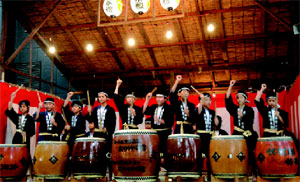 <-
Okubo daiko drum performance at a local shrine. Okubo daiko, which the sixth
graders at Okubo Elementary School practice and perform at local festivals
every year, brings children of different backgrounds together. Before, the
school was seen as “a foreigners’ school” due to the large
number of children of other backgrounds. Now, however, the school, in cooperation
with neighborhood associations, takes part in various community activities
in an effort to forge closer ties with local citizens.
<-
Okubo daiko drum performance at a local shrine. Okubo daiko, which the sixth
graders at Okubo Elementary School practice and perform at local festivals
every year, brings children of different backgrounds together. Before, the
school was seen as “a foreigners’ school” due to the large
number of children of other backgrounds. Now, however, the school, in cooperation
with neighborhood associations, takes part in various community activities
in an effort to forge closer ties with local citizens.
In the Community: Takatori Community Center
Enriching Society through Minority Voices
Takatori Community Center is a non-profit organization dedicated to promoting the coexistence of various cultures within the community. In Nagata ward in the city of Kobe, where Takatori Community Center is located, nationals of other countries make up 10 percent of the population. After the 1995 Kobe earthquake, 5 the forerunner of Takatori Community Center, Takatori Kyokai Kyuen Kichi (Takatori Church Aid Center), provided information about evacuation sites and relief supplies in multiple languages and served as headquarters for volunteer activities. Non-Japanese victims of the earthquake not only received aid; they rescued people from the rubble and prepared hot meals outdoors, giving each other emotional support. Once they began to obtain information, many used their language abilities and technical skills to the fullest in dealing with the crisis. After the disaster, the Community Center began efforts to provide a forum for the voices of non-Japanese residents—which are easily silenced in society—to be heard. Yoshitomi Shizuyo, director of the Community Center, says that such a forum gives confidence to minorities, and is healthy for Japanese as well, increasing opportunities to gain new perspectives and realize that diversity is something happy and enriching.
A Forum for Children to Express Themselves
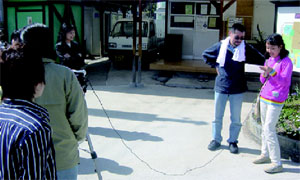 Re:C
not only aims to help children express themselves, but also to forge relationships
with people in the community. ->
Re:C
not only aims to help children express themselves, but also to forge relationships
with people in the community. ->
Children’s as well as adults’ voices need to be heard. Children of other ethnic backgrounds are self-conscious about their Japanese language ability, and many have trouble understanding what is said in classes, in making friends, and building confidence in themselves. The Community Center provides an opportunity for children who have trouble communicating verbally to express their ideas using video or animation through a program called Re:C. Once every week, about fifteen children of other cultural backgrounds ranging from preschool age to junior high school gather at the Re:C salon. They make videos about their communities and themselves and hold screenings in the community and on the Internet.
Through these creative processes, children reflect upon their own thoughts and give shape to them, then present them to others. Receiving responses from those around them builds confidence, and they become motivated to create more videos.
Changes in Ourselves and Those Around Us
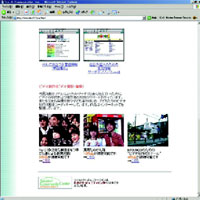 <-
Videos made by children at Re: C can be viewed all over the world via the
Internet.
<-
Videos made by children at Re: C can be viewed all over the world via the
Internet.
http://www.tcc117.org/rec
When she arrived in Japan seven years ago, one third-generation Japanese Brazilian
who is now a first-year student in high school suffered a crisis in self-confidence.
She could not speak Japanese, and she could not do the things that most of
the Japanese children around her could, such as flips on the horizontal bar,
riding a unicycle, and vaulting in gym class. Not wanting to be seen as different,
she tried to hide the fact that she was a foreigner. At Re:C, she says, she
can believe in herself; it is a place where people support her, and where she
can just be herself. She is making a video of the ocean and aquariums, which
she says she finds “calming.” She says that in the process, she’s had experiences —such as listening to others’ opinions and following through in spite of the mistakes she’s made—that have helped to change her.
The activities at Re:C change not only the students making videos, but other people who have been involved with its program, such as the staff and those who see the children’s video works. Japanese college student volunteers work with the children as coordinators to identify topics, create scripts, film, and edit on the computer. They keep watch as the children struggle over things, at times agonizing with them, finding that they also sometimes have to question and rethink their own identity. Their perspectives are broadened as they begin to see a Japan they had never seen before. After the experience of working with these children, some young people choose careers in education to find ways to enhance the education system.
In one of the videos created by the children, an aquarium staff member who was interviewed commented that he knew Brazilian fish very well but that he realized he didn’t know anything about Brazil or Brazilians aside from scattered information from books and television. Young people who have seen the videos made at Re:C have said, “I, too, won’t give up,” and “I want to think more about the friends around me.”
From Empathy for Each Other to a Multicultural Society
The feelings about family that one Japanese Brazilian student expressed in her work is something that can be shared by both Japanese and those from other countries. Murakami Keitaro, who is in charge of Re:C, says, “To realize a multicultural society, of course we have to change laws and institutions. But first, it is vital that individuals change themselves inside.” He continues, “The willingness to move away from old habits of estrangement because you don’t know people well to developing empathy for them as fellow human beings becomes the starting point from which you can understand the problems concerning people who live as minorities in a society and make changes in society.”
In Towns and Cities: City of Ota, Gunma prefecture
Efforts to Relax Regulations
Ota is an industrial city in Gunma prefecture, where the main industry is auto manufacture. To resolve its labor shortage, the city actively recruited workers from overseas, particularly those of ethnic Japanese background, and by the end of 2005, the number of residents from overseas reached about 4 percent of the total population, or approximately 9,000 people, of which nearly half are second-generation and third-generation Japanese Brazilians. The number of students with non-Japanese citizenship enrolled in elementary and junior high schools in Ota is approximately 400, or about 2 percent of the total student population. Brazilian nationals make up 60 percent of this number.
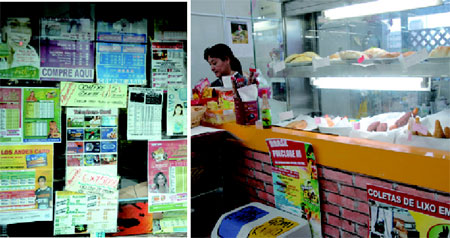
(left) Window of a shop is covered with flyers in Portuguese. (right) Shop selling Brazilian bread and prepared foods. Many Brazilians stop by on their way home from work.
Special District Educational Strategies
To respond to the growing numbers of children of nonJapanese parentage, in 1991 the city of Ota set up Japanese language instruction classes in the city’s elementary schools, employing assistants who could speak the students’ first languages to teach Japanese or interpret for the students. Even though they were academically capable, many of these students could not go on to senior high school or university because their Japanese language abilities were insufficient. Recognizing that assistants and interpreters were not enough, but that teachers were needed who could speak the students’ first languages and could teach Japanese or other subjects in order to improve these students’ abilities and to broaden their future options, the city applied for the status of “special district for education of foreign children and students for permanent residence,” which was granted in March 2004. This allowed the employment, at the expense of the city, of people who may not be certified as teachers in Japan, but are certified in other countries.
6
As a result, bilingual Japanese/Portuguese instructors with Brazilian teaching certificates were hired to teach Japanese and other subjects in cooperation with additional teachers and Japanese instruction assistants.
A bilingual elementary school teacher in the city, Suenaga Sandra Terumi, says that, along with the subject itself she teaches Japanese phrases that are important to know in any subject. (For example, in math class, she teaches sentences such as “The vertical line is longer than the horizontal line,” or “The red ribbon is the longest.”) Because she can use the students’ first language to explain things they have a difficult time grasping, students are able to further their understanding. The strength of the bilingual teacher is this ability to conduct both Japanese language instruction and subject instruction at the same time.
Special District Status Applicable Nationwide
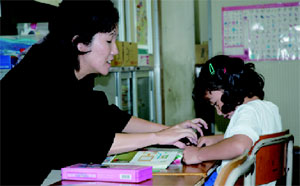 A
class in the international studies room. Suenaga says that having someone who
understands them, more than being able to understand Japanese or the subject
matter, is reassuring to the students. When students fight with each other
and can’t express themselves to their homeroom teachers, or when they
want to talk about something that’s happened at home, they come to Suenaga
to speak in Portuguese. ->
A
class in the international studies room. Suenaga says that having someone who
understands them, more than being able to understand Japanese or the subject
matter, is reassuring to the students. When students fight with each other
and can’t express themselves to their homeroom teachers, or when they
want to talk about something that’s happened at home, they come to Suenaga
to speak in Portuguese. ->
The recent increase in the number of students of non-Japanese ethnic background who go on to local high schools is considered to be the result of the aforementioned efforts. The special consideration extended to Ota city as a special district was made available nationwide in April 2006. The “special district” program, part of the nation’s structural reform, was designed to relax regulations in such districts so that once they were found to be workable the status would be applied all over the country. The precedent set by the city of Ota may still be in the process of blossoming to its full potential, but it is undoubtedly spreading all over Japan.
First Step toward a Better Society
Japanese society has long considered itself to be homogeneous. The society was unwilling to acknowledge those who were different and inclined to demand that everyone be the same. However, Japanese society has come to a point when citizenship, culture, and language alone cannot fully distinguish between “foreigners” and “Japanese.” It is now home to growing ethnic and cultural diversity. If society as a whole responds to and accepts those differences, it will be a better place not only for people from other countries but also for the increasingly diverse Japanese themselves. There are still many problems and we have just only begun, but at least we have made the first step.
1 South Korean and North Korean residents of Japan: This includes people who were forced to come to Japan in the 1920s from the Korean peninsula, which was a Japanese colony at the time, and their descendents. After World War II they were stripped of their Japanese citizenship, reverting to Korean citizenship. Presently, approximately 450,000 Koreans are registered as special permanent residents (in addition, there are Korean residents of Japan who have become citizens or who have married non-Koreans). Foreigners who have come to Japan from the 1990s onward are called “newcomers,“ as opposed to the aforementioned “oldcomers.”
2 Ethnic Japanese: Since the Immigration Control and Refugee Recognition Act underwent revision in 1990, the immigration restrictions on people of Japanese ancestry were relaxed, resulting in a rise in ethnic Japanese from South America who have come to Japan accompanied by their families.
3 They are children of various national, cultural, linguistic, and ethnic backgrounds, including those with non-Japanese citizenship, those with non-Japanese citizenship whose first language is Japanese (because they came to Japan when they were young, etc.) and those with Japanese citizenship who require special Japanese language instruction for various reasons (born in Japan to non-Japanese parents, grew up overseas, etc.).
4 Beginning in 1992, the Ministry of Education, Culture, Sports, Science and Technology (MEXT) has placed additional teachers in schools with children who require Japanese-as-a-second language (JSL) instruction. MEXT also produces Japanese teaching materials, sponsors training programs for teachers, and develops JSL curricula.
5 Kobe Earthquake: Early in the morning on January 17, 1995, a strong epicentral earthquake with a magnitude of 7.3 on the Richter scale hit Kobe and northern Awaji Island. It was the country’s biggest earthquake disaster since the end of World War II, leaving 6,433 dead and 43,792 injured. Over 300,000 people were evacuated. The city center of Kobe was devastated. The number of volunteers who helped victims immediately after the earthquake is said to have reached, on average, over 20,000 people per day. The general public’s recognition of volunteerism in disaster-stricken areas skyrocketed.
6 Generally, teachers in public elementary and middle school are hired by either the prefecture or ordinance-designated municipality.
Original text : Takarabako No.10 “Japanese
Culture Now” December
2006.
Copyright(C)1997-2008 The Japan Forum. All rights reserved.
Send feedback to forum@tjf.or.jp